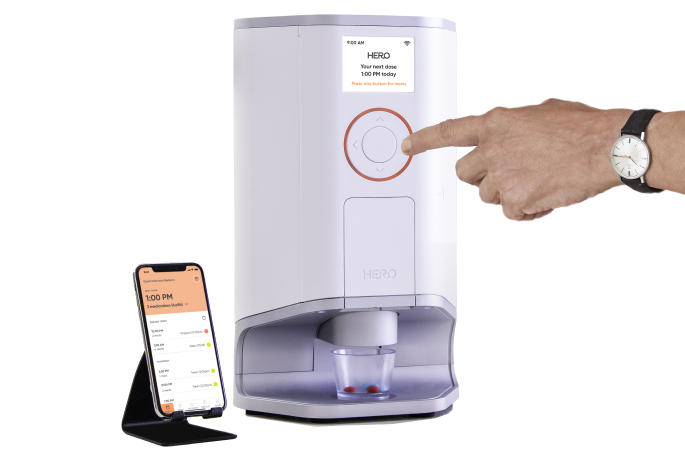When Prescriptions Pile Up: An Introduction to Polypharmacy

About the Author: Stephen J. Kogut PhD MBA RPh is a pharmacist and professor at the University of Rhode Island College of Pharmacy, where he conducts research on medication adherence, prescription drug costs and patient health outcomes.
Edited by Léa Bourgade, Content and Community Manager at Hero.
For many Americans, taking prescription medications is as routine as walking the dog or brushing your teeth. Whether to prevent disease, manage chronic conditions, alleviate pain with analgesics, mitigate risk factors, or enhance the quality of life, prescription medication use is often a common facet of daily living.
While prescription drugs can undoubtedly provide important health benefits, there can also be risks to taking medication. These risks increase substantially with each additional medication used - a phenomenon known as polypharmacy.
In this article, we’ll cover the prevalence of polypharmacy in the US, its associated risks, and how medications can interact to cause harm. Later, we’ll offer several suggestions to minimize risks associated with polypharmacy, and strategies to reduce the number of medications prescribed.
Please be mindful that a decision to discontinue a medication should be made under the guidance of a health care provider, after careful evaluation of a medication’s risks and benefits. The abrupt discontinuation of certain medications can cause serious harm.
The burgeoning use of prescription medication in the United States
With age often comes disease, and with disease often comes medication use. By age 65, more than 50% of adults have multiple chronic conditions, and this percentage increases with advancing age.1 During the past several decades, a plethora of pharmaceuticals have been developed to address common chronic conditions among elderly people. Beginning with the first medications for hypertension in the late 1940s, drug development for chronic disease accelerated with innovations in pharmaceutical chemistry and large-scale manufacturing. By the end of the 1990s, more than 1,000 drugs were approved by the US Food and Drug Administration.2
National survey data indicate that prescription medication use among the elderly population roughly doubled between 1988 and 2010, from a median of 2 to 4 prescribed medications.3 More recently, a study of over 25 million Medicare beneficiaries reported that the average senior used 5.6 prescriptions in 2016.4
Those with certain health conditions may require an even greater number of medications. For example, heart failure is one of the most common causes of hospitalization among older adults and can result in patients being prescribed 10 or more medications at discharge.5 High levels of polypharmacy are also common among residents of long-term care facilities, where clinicians prescribe most residents at least five different medications, and as many as two-thirds receive at least 10 medications.6 Among older adults who are not in a nursing home, as many as 45% of seniors use five or more prescription medications.7 Moreover, these estimates do not include the use of over-the-counter products and dietary supplements, which are taken by a majority of older adults.8
What Exactly is Polypharmacy?
Physicians and health researchers have long been concerned about the harms of using too many medications. The term polypharmacy was penned in the medical literature more than a century ago in reference to the use of multiple drugs,9 much like a polygon has many sides, or a polyphonic recording captures numerous sounds. Today, the term polypharmacy not only implies a concerning risk of harm but can also allude to the inappropriate prescribing of medication.
Still, polypharmacy is not simple to identify in a patient. Multiple medications, for instance, can often be required to address the range of health conditions that afflict older patients. Moreover, clinical treatment guidelines for hypertension, diabetes, mental health disorders, and many other conditions recommend combining certain drugs for patients with progressing disease.
Given this information, it is easy to see how a person with multiple health conditions may require an increasing number of medications. Renowned drug epidemiologist Jerry Avorn, MD once remarked that "as elderly patients move through time, often from physician to physician, they are at increased risk of accumulating layer upon layer of drug therapy, as a reef accumulates layer upon layer of coral.”10
But while each prescribed medication may have a valid reason for use, the totality of risk caused by consuming multiple pharmaceuticals still merits careful assessment. The likelihood of harm can depend on the particular mix of medications, but may also be affected by a person’s health status and genetics, which influence how medications act within an individual. With these different factors at play, there is no “magic” number of prescriptions that represents an unacceptable degree of risk. However, abundant research has documented that the risk of medication-related harm generally increases with the number of medications used.11
Recognizing the Contributing Factors to Polypharmacy
A drug is a substance that is intended to favorably affect a function of the body. But due to the complexity of our physiology, any alteration of our internal functioning has the potential to cause unintended consequences. Just as buying additional raffle tickets increases the odds of winning, each additional medication prescribed increases the chance of experiencing an adverse effect.
There are several ways that inappropriate medication use can interact to cause harm:
- Drug-food interactions are perhaps the most well-known type of drug interaction. Many medications require administration on an empty stomach to ensure effectiveness, while other drugs should be taken with a meal. Some foods can dramatically increase drug concentrations to a toxic level. For example, patients have developed life-threatening kidney failure from the daily consumption of grapefruit juice with certain medications for high cholesterol.12 Prescription drugs can also interact with calcium-rich foods, fermented products, vegetables high in vitamin K, and alcoholic beverages. Avoiding drug-food interactions becomes increasingly challenging when many medications are prescribed.
- Drug-disease interactions occur when a medication for one health condition can worsen another disease. For example, some types of blood pressure medication can exacerbate asthma, while steroids used for inflammatory conditions can worsen diabetes and hypertension. There are numerous other examples of drug-disease interactions that can occur with polypharmacy.13
- Drug-drug interactions occur when two or more medications conflict. Such interactions can be dangerous in the following ways:
- Medications can interfere with each other when dissolving internally; for example, magnesium or iron supplements can bind to an antibiotic and render it ineffective.
- Drug interactions can also occur while medications are circulating in your blood, such as when one medication displaces another medication from the cell surface.
- Interactions can also occur when one drug affects how another drug is broken down by the liver. For instance, one drug’s effectiveness can be reduced if its metabolism is accelerated by another medication.
- A more perilous situation occurs when the metabolism of a drug is hindered by another drug, causing its blood levels to become dangerously elevated. This may cause an array of adverse consequences, such as a fall, a seizure, or sudden death from arrhythmia. Predicting interactions involving drug metabolism can be a challenge for prescribers and pharmacists. Genetic variations create differences in how individuals process medications. Moreover, our understanding of drug interactions is predominantly based on theory, as large-scale clinical studies of drug interactions are generally scant. And while prescribers and pharmacists endeavor to steer clear of the most well-known drug interactions, polypharmacy increases the likelihood that the metabolism and blood levels of some drugs are affected by other medications.
Beyond fears about drug interactions, polypharmacy in older adults is also a concern due to the physiologic changes associated with aging. As kidney functioning declines, for instance, the ability to efficiently excrete medications in urine is lessened, potentially causing a drug to accumulate to an unsafe level. Moreover, age-related decline in brain function can accentuate the cognitive effects of medication. Polypharmacy may even result in a “medication fog” syndrome, causing confusion and dementia-like effects.14
Lastly, the hazards of polypharmacy are heightened by the fragmented nature of the US healthcare system. Patients often have multiple prescribers and may also use multiple pharmacies. It is challenging for health care providers to maintain a comprehensive medication list. Moreover, health care providers may not have the time to carefully review a person’s medications when prescribing a new drug or may lack knowledge about a medication that they do not frequently prescribe.
Outcomes of Polypharmacy: What Does the Research Show?
Polypharmacy usually indicates multimorbidity - in other words, the presence of multiple health conditions. Yet, at times, it can be difficult to disentangle the symptoms of disease from the negative effects of polypharmacy. For example, it may be impossible to know if a person’s fall was the result of overmedication, or from a dizzy spell caused by a cardiac problem. Nevertheless, researchers have documented clear associations between polypharmacy and a range of adverse health outcomes, including dementia, worsening frailty and death.11,15 One review of multiple studies found that individuals prescribed 10 or more drugs had nearly twice the risk of death as compared with those using fewer medications.11
In addition to potential increased risks of medical events, increased side effects, adverse drug events, and worsening of health status, polypharmacy can also diminish a person’s quality of life. Whether it’s constipation, decreased appetite, fatigue, unsteadiness, or vision changes, these symptoms can have a significant impact on a patient’s ability to engage in meaningful social activities.
Finally, polypharmacy has economic consequences. Even those with prescription drug coverage can have difficulty affording the totality of copayments, causing some people to skip doses or go without medication. Polypharmacy also exacts a high cost burden on the US healthcare system, accounting for roughly 750 hospitalizations daily, and potentially more than $5 billion in healthcare spending annually.16
Addressing Polypharmacy: What Can Be Done?
Prescription medication can be a two-edged sword. Many lives will benefit from prescription drugs, yet careful monitoring and management are necessary to avoid serious risks of harm, especially when multiple medications are prescribed.
One overarching strategy to reduce the risks associated with polypharmacy is to ensure that medication lists are reviewed by a health care provider at every visit. This review should consider both the intended benefits and potential risks of each medication in relation to the patient’s health-related goals.
It is also crucial that patients and/or their family caregivers understand why each medication has been prescribed and for how long it is to be used, and are aware of the potential signs of adverse drug events and reactions. Particular attention is required after a hospitalization or the use of long-term care services because the transition from these care settings is often associated with medication changes.
Additionally, there are some types of medications that may be appropriately de-prescribed in certain circumstances:
- Medications for conditions that resolve: Health symptoms can change over time, and so too can the need for medication. For example, a change in diet might eliminate the need for a heartburn drug. Similarly, medications for anxiety, insomnia, and hay fever are examples of drugs that may not be required chronically.
- Medications after a significant change in health status: Have you recently lost weight or started a new exercise regimen? Dramatic and sustained improvements in health may require a change in the medication regimen, or perhaps even warrant a prescriber to discontinue a particular drug.
- Medications after an acute illness or injury: Cough and cold medications, certain respiratory inhalers and anti-inflammatory drugs are examples of medications that may be intended for a limited duration of use. Such short-term therapies may often be inadvertently continued.
- High risk medication combinations: For some medication mixtures, the potential hazards may outweigh the benefits of continued use--particularly if one’s health condition is worsening. For example, the long term concurrent use of opioid medications and central nervous system depressants is a particularly high-risk combination that may cause death from overdose. As another example, polypharmacy involving blood thinning medications can increase the risk of bleeding events. Be sure to consult your doctor and pharmacist to know which medications in a prescribed regimen present the greatest degree of risk, and what to watch for to detect potential adverse effects before they cause significant harm.
Beyond avoiding drug interactions, risks may also be lessened by reducing the complexity of polypharmacy. Complex regimens increase the likelihood that patients will fail to take medications as directed, and combination pills can help to lessen this complexity. While the number of options can be rather limited, there are combination pills of medications for conditions like depression, diabetes, high cholesterol, HIV and hypertension. Additionally, medications that require multiple daily doses, such as antidepressants, may be available in a sustained-release formulation that can be taken once daily. Streamlining the pill burden can help to reduce errors and promote adherence; ask your prescriber and pharmacist about available options.
Still, many patients will be unable to substantially lessen the number of pills they must take each day. Polypharmacy increases the risk of forgetting to take medications when they are due, and even becoming overwhelmed by the number of drugs prescribed. Pill organizers can be somewhat helpful, although they seldom have the necessary compartments and labeling to accommodate a complex medication regimen, and lack advanced features that can promote adherence. Automated dispensing devices such as the Hero medication dispenser can help to manage this complexity and promote safer outcomes of polypharmacy by automatically sorting your medications and sending you timely reminders when it's time for a dose.
Finally, if managing the risks of polypharmacy seems overwhelming, remember that your pharmacist is an essential resource and ally. Seek to develop a strong rapport with those dispensing your medications. When it is safe to do so, pick up new prescriptions in person to receive important counselling points, and be sure to ask about potential interactions with other prescribed and over-the-counter medications in your regimen.
Polypharmacy: a complicated problem with no easy solution
It would be a mistake to be Pollyanna about polypharmacy. The risk of drug-related harm increases with the number of medications prescribed, causing a perilous balance between the benefits of medication and the substantial risks of polypharmacy.
Fortunately, there are steps one can take to lessen these risks. Start with being an informed patient, aware of the potential signs of adverse effects and knowing how to respond. Having a system to manage multiple medications is also important, and devices that automate medication schedules and provide alerts can be particularly helpful. It is also essential to review medication lists at each office visit, and to develop a close relationship with your pharmacist. With these measures, patients can more safely experience the intended benefits of their medication regimen.
References
1. Aprahamian I, Morley JE. Editorial: To Drug or Not to Drug: The Geriatrician Dilemma of Polypharmacy. J Nutr Health Aging. 2020;24(8):809-811.
2. Gaffney A. (Regulatory Focus News Article). How Many Drugs has FDA Approved in its Entire History? Published October 3, 2014. Available at: https://www.raps.org/regulatory-focus%E2%84%A2/news-articles/2014/10/how-many-drugs-has-fda-approved-in-its-entire-history-new-paper-explains. Accessed January 6, 2021.
3. Charlesworth CJ, Smit E, Lee DS, Alramadhan F, Odden MC. Polypharmacy Among Adults Aged 65 Years and Older in the United States: 1988-2010. J Gerontol A Biol Sci Med Sci. 2015 Aug;70(8):989-95.
4. Ellenbogen MI, Wang P, Overton HN, Fahim C, Park A, Bruhn WE, Carnahan JL, Linsky AM, Balogun SA, Makary MA. Frequency and Predictors of Polypharmacy in US Medicare Patients: A Cross-Sectional Analysis at the Patient and Physician Levels. Drugs Aging. 2020 Jan;37(1):57-65.
5. Unlu O, Levitan EB, Reshetnyak E, Kneifati-Hayek J, Diaz I, Archambault A, Chen L, Hanlon JT, Maurer MS, Safford MM, Lachs MS, Goyal P. Polypharmacy in Older Adults Hospitalized for Heart Failure. Circ Heart Fail. 2020 Nov;13(11):e006977.
6. Jokanovic N, Tan EC, Dooley MJ, Kirkpatrick CM, Bell JS. Prevalence and factors associated with polypharmacy in long-term care facilities: a systematic review.
J Am Med Dir Assoc. 2015;16(6):535.e1–12.
7. Hsu HF, Chen KM, Belcastro F, Chen YF. Polypharmacy and pattern of medication use in community-dwelling older adults: A systematic review. J Clin Nurs. 2020 Dec 15. Epub ahead of print.
8. Qato DM, Wilder J, Schumm LP, Gillet V, Alexander GC. Changes in Prescription and Over-the-Counter Medication and Dietary Supplement Use Among Older Adults in the United States, 2005 vs 2011. JAMA Intern Med. 2016 Apr;176(4):473-82.
9. Clarke MD. Therapeutic Nihilism. Boston Surgical and Medical Journal. Vol 119;July-Dec 1888. Page 200.
10. Gurwitz JH. Polypharmacy: A New Paradigm for Quality Drug Therapy in the Elderly? Arch Intern Med. 2004;164(18):1957–1959.
11. Leelakanok N, Holcombe AL, Lund BC, et al. Association between polypharmacy and death: a systematic review and meta-analysis. J Am Pharm Assoc. 2017;57(6):729–738.
12. Bailey DG, Dresser G, Arnold JM. Grapefruit-medication interactions: forbidden fruit or avoidable consequences? CMAJ. 2013 Mar 5;185(4):309-16.
13. US Food and Drug Administration. Drug Interactions: What You Should Know. Available at: https://www.fda.gov/drugs/resources-you-drugs/drug-interactions-what-you-should-know. Accessed January 6, 2021.
14. Amy Jamieson (Lown Institute). ‘Medication Fog’: What It Is and How It Can Cause Dementia-Like Symptoms. Published March 14, 2020. Available at: https://lowninstitute.org/in-the-news/medication-fog-what-it-is-and-how-it-can-cause-dementia-like-symptoms/. Accessed January 2, 2020.
15. Leelakanok N, D'Cunha RR. Association between polypharmacy and dementia - A systematic review and metaanalysis. Aging Ment Health. 2019 Aug;23(8):932-941.
16. Eliminating medication overload: A national action plan. Working Group on Medication Overload.Brookline, MA: The Lown Institute, 2020.
Complex med schedule? We solved it.
Hero’s smart dispenser reminds you to take your meds and dispenses the right dose, at the right time.

The contents of the above article are for informational and educational purposes only. The article is not intended to be a substitute for professional medical advice, diagnosis, or treatment. Always seek the advice of your physician or other qualified clinician with any questions you may have regarding a medical condition or its treatment and do not disregard professional medical advice or delay seeking it because of information published by us. Hero is indicated for medication dispensing for general use and not for patients with any specific disease or condition. Any reference to specific conditions are for informational purposes only and are not indications for use of the device.



